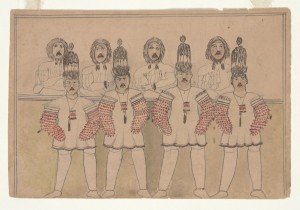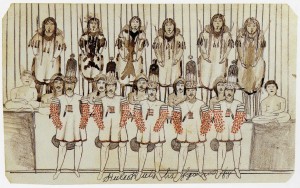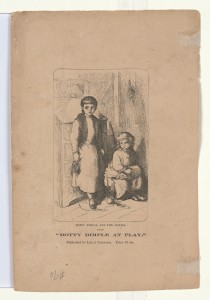Drawing B
King Island Eagle-Wolf Dancers
Notes on Content:
Elizabeth Hutchinson (instructor) with help from Heidi Senungetuk:
The long mittens and tall headdresses in this image are today the typical regalia worn for the Wolf Dance by dancers from King Island (as shown in the video on the first page of this website). This may indicate that this drawing represents one of the groups who gathered from the Bering Strait region to perform in the Messenger Feast and that the artist took care to make each group distinct and recognizable.
Notes on Form/Style:
Cannelle Bruschini (student):
The artist emphasized the accessories characteristic of the Wolf Dance since the mitten and the headdresses are the most detailed elements of the drawing. The rest of the clothing have no color, no shadow and no decoration.
Elizabeth Hutchinson (instructor):
The similarity between this drawing and a very similar one in the Wickersham Papers at the Alaska State Libraries suggests strongly that this drawing is by Etoachna.
Interestingly, Etoachna’s drawing shows five dancers in the regalia typical of King Island, while the Columbia drawing shows the number that participate today: four. This drawing is part of a suite of six images of the Wolf Dance, including one very similar to drawing D.
On the verso of this drawing is the following print:
Elizabeth Hutchinson (instructor)
This image illustrates a scene from the popular children’s books by Rebecca Sophia Clarke featuring Dotty Dimple. These books were reprinted for decades after their initial publication in the 1860s and 1870s. This image and the others on the backs of the drawings in this exhibition
Clarke’s heroines were known for their humor and taste for mischief and because of this her books were thought of by many as more appealing and realistic than the depictions of perfectly behaved children in other works of juvenile literature. This illustration, which shows the heroine with “the Jewess,” a girl named Lina Rosenberg with whom Dotty is not allowed to play. The picture reinforces the Dotty’s elevated position as a Anglo-American child and indicates the book’s message of offering kindness to people of other races, nationalities, religions and abilities. It is probably that the Dotty Dimple books were among those the Lopps shared with their students; literature like this reinforced the lessons of settler colonialism offered by the presence of the missionaries and their school.



Leave a Reply
You must be logged in to post a comment.